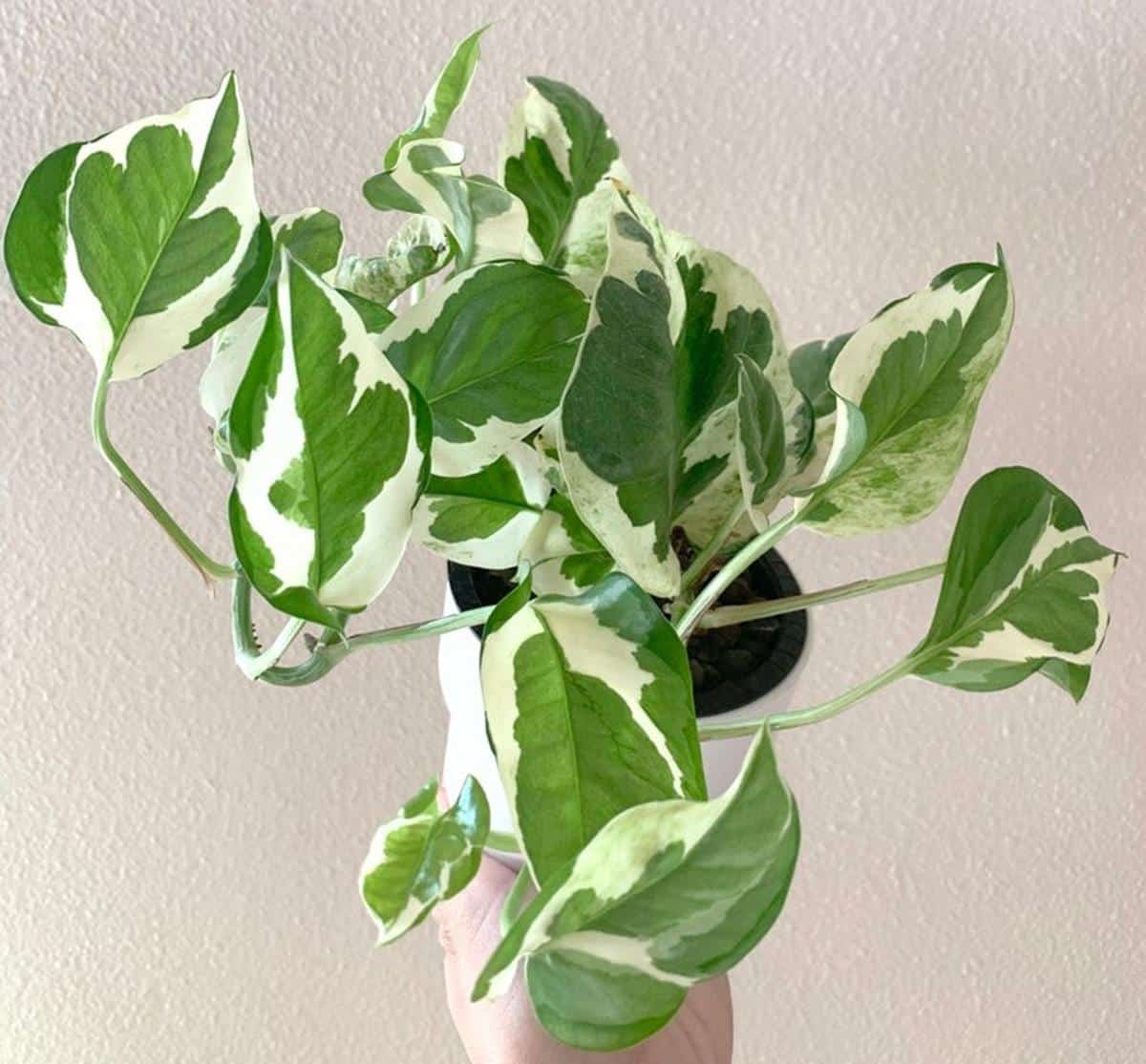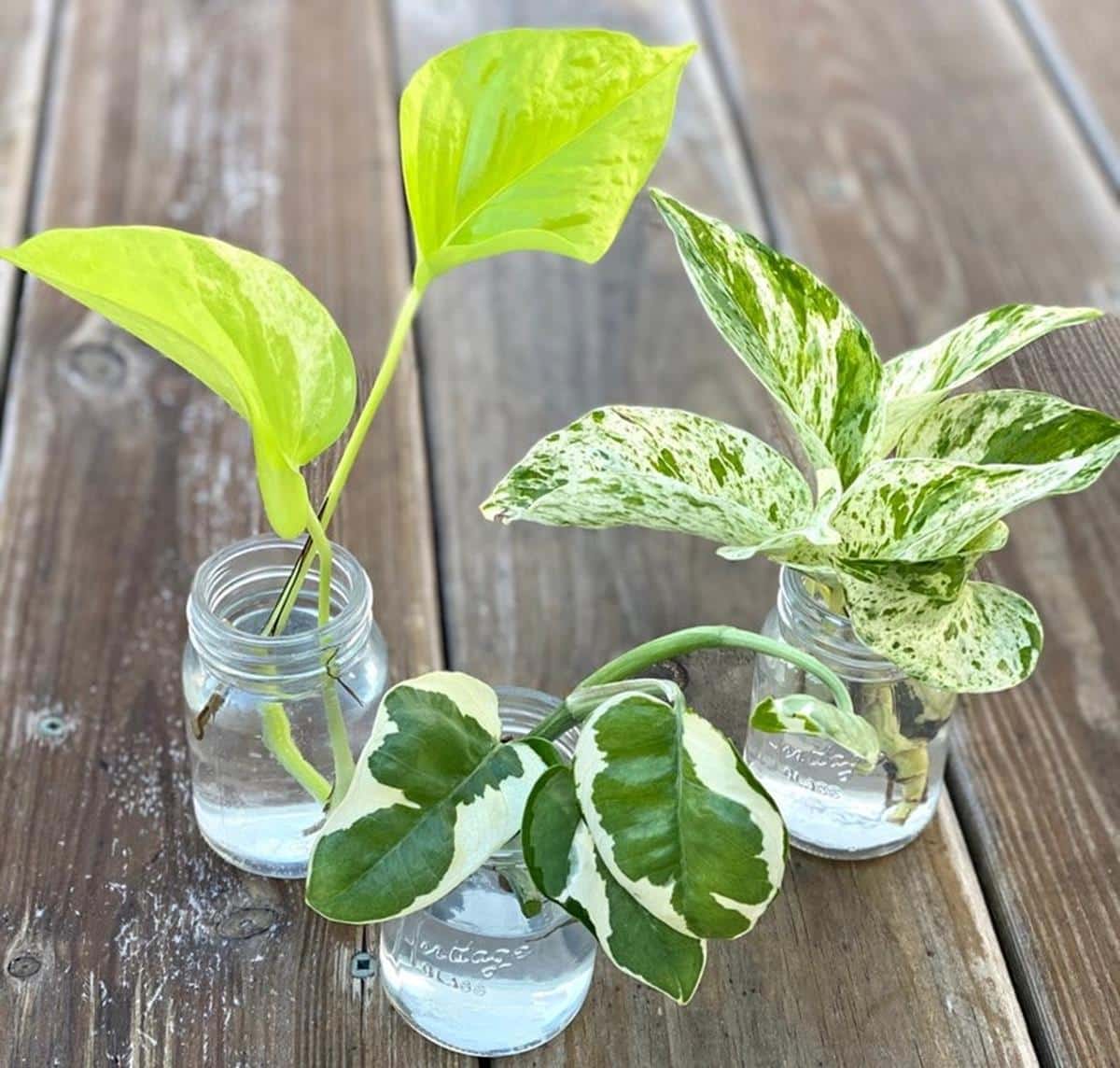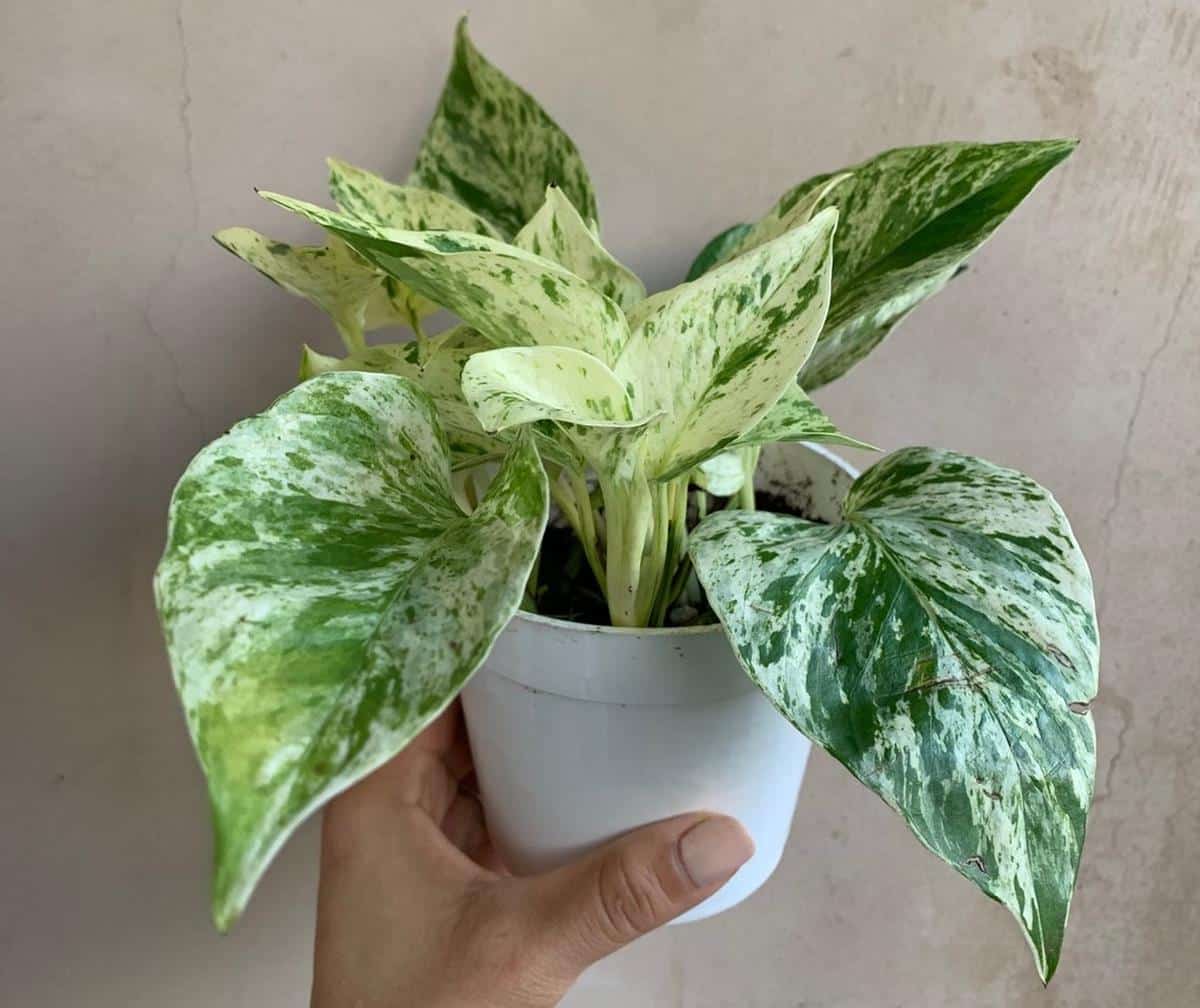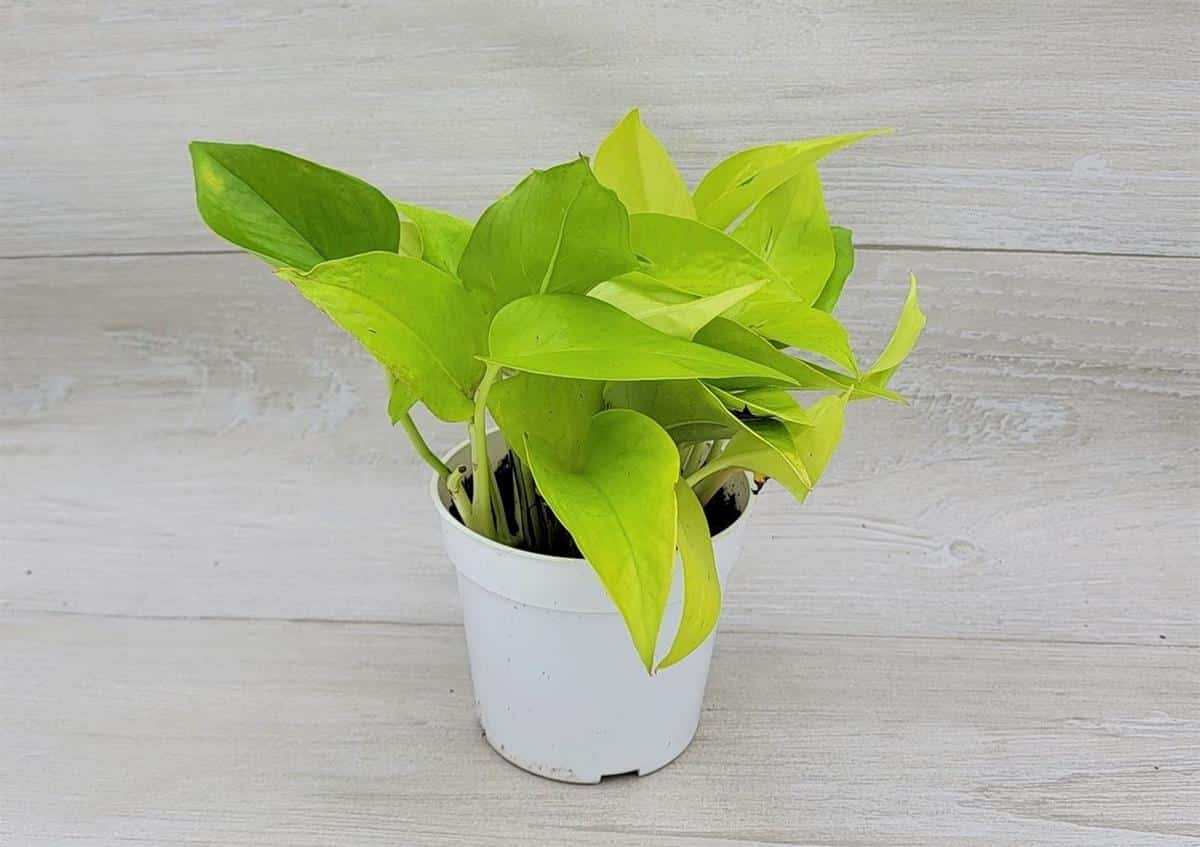Pothos leaves curling in or upward is caused by underwatering, too much light, low humidity, heat stress, cold drafts, or being rootbound. They are rolling or cupping to help conserve moisture.
On the other hand, if your pothos plant leaves curl under, outward, or downwards, it may be overwatering, deficiency of nutrients, pests, diseases, or excess fertilizers. But some of these causes may make your leaves distorted, deformed, ruffled, and curled upward, under, or downwards.
Please note that the various reasons and fixes for pothos curled leaves apply to any variety, including your golden, marble queen, or silver satin leaves.
Last but not least, we will also give you other signs to expect for each cause and solution or what to do. This way, you can pinpoint the possible cause in your unique case.

Contents
- Pothos care and growing requirements
- Pothos leaves curling causes, signs, and fixes
- 1. Underwatering and pothos plant curling leaves
- 2. Overwatering and root rot
- 3. Low humidity
- 4. Does heat stress cause pothos leaves curling?
- 5. How do cold drafts cause pothos curling leaves
- 6. Rootbound
- 7. Too much fertilizers or deficiency of some nutrients
- 8. Pests
- Normal reasons for pothos leaves curling
- 1. Aging
- 2. Plant shock
- 3. New leaves
- More about pothos
Pothos care and growing requirements
Most of the reasons why your pothos leaves are curling have to do with the care and growing conditions you give them. Thus, we thought it better we give you the below summary. It will help you quickly identify where you may be going wrong.
| Care level | Low or easy |
| USDA hardiness zone | 10 to 12 |
| Temperature | Pothos grows best at 65 to 85°F. But they can tolerate temperatures of up to 90°F or as low as 55°F |
| Humidity | Average to high, at least 50% or more, ideally 50 to 70% |
| Light requirement | Bright, indirect light but won’t mind low to medium light |
| Best soil | Well-drained, nutrient-rich, slightly acid soil with pH 6.1 to 6.5 |
| Watering | Medium. Water your pothos when the top 50-75% of the soil is dry. |
| Fertilizer | Feed your pothos with a balanced, 10-10-10 or 20-20-20 houseplant fertilizer monthly or after one and a half months during the growing season. |
| Pruning and grooming | Use a sterilized pruning knife to cut any dying, discolored, damaged, or dead leaves. During growing seasons, you can also cut a few branches or stems from control growth and shape. It will make the plant fuller. |
| Repotting | Repot your pothos after about two years or when rootbound |
| Propagation | Stem cutting in water or soil |
| Toxicity | Toxic or poisonous to humans, cats, dogs, and other pets |
Pothos leaves curling causes, signs, and fixes
It is time to look at the various causes for pothos leaves curling up, under, or downwards.
1. Underwatering and pothos plant curling leaves
Underwatering is the number one reason for pothos leaves curling inward or upward. When thirsty, pothos will cup or roll their leaves inward to reduce their surface area, minimizing water loss.
Underwatering signs
- Dry soil pulled from pot edges
- Leaves will feel dry and start curling in. Also, they may have brown crispy margins and edges and turn yellowish.
- A limp, drooping, or wilting plant
- Slow or stunted growth with leaves becoming smaller than usual
- Withering and death
- Defoliation
What to do
If the soil feels dry past a few inches or up to the first knuckle of your finger, water them thoroughly until excess water comes from drainage holes. Pour any that collects on the saucer.
You can also know when to water using a soil moisture meter. We love XLUX Soil Moisture Meter. It is accurate, responds fast, and is one of the top-rated brands.
Next, switch from a watering schedule to watering when the soil feels dry. Come up with a rough estimate of how often you water these plants and set a reminder. But don’t forget first to feel the soil.
Last but not least, check if your potting mix that holds moisture and other growing conditions are optimum. If your soil dries so fast, add some coco coir or peat moss. They will help hold moisture.
2. Overwatering and root rot
Overwatering is the other reason for pothos leaves curling. It makes the soil soggy and chokes oxygen from the plants. Without oxygen, they cannot absorb nutrients or even water well.
To make matters worse, if you don’t correct the problem, your plant may end up with root rot. Root rot will further minimize its ability to absorb water and minerals or even kill your plant.
Overwatering signs
- Soggy or wet soil even after not watering for a few days
- Leaves curling downward
- There will be yellowing of leaves, starting with the lower ones. Also, there may be brown or black splotches.
- Limp, droopy plant with leaves that feel soft. Not crispy and dry as in the cause of underwatered pothos.
- Musty stem and moldy potting mix
- Leaf edema
- Leaves dropping
- Slow or no growth
What to do:
Don’t water your plant until the top 50-75% of the soil is dry. This will help solve the issue of watering too often.
Next, find out why your potting mix takes a long time to dry. A heavy or compacted soil will result in overwatering. Consider amending it or buying an aroid mix. See Etsy.com.
Other things to do is check if the pot is oversize, drainge holes are open. If all is ok, use a pencil to poke holes in the soil to help aerate it.
That is not all. You need to improve room ventilation and ensure optimum growing conditions. During this time, don’t fertilize your plant.
If your plant has root rot, you will have to repot it. But don’t forget to cut any brown or black roots with a sterile pruning knife or scissors.
3. Low humidity
Low humidity or dry air will cause fast water loss from leaves and soil. If the rate exceeds what roots absorb, your pothos leaves will start curling in to conserve moisture.
Signs
Besides a potting mix that isn’t so dry, other signs resemble those of a thirsty pothos. Also, your hygrometer will read low values, and your potting mix will dry fast.
What to do
Mist your plants a few times a week or have a pebble tray. Also, group your plants and move them to rooms with high humidity, like your bathroom or kitchen.
To ensure we have adequate humidity, we use a humidifier. We have two brands, AquaOasis™ Cool Mist Humidifier for our smaller room and LEVOIT Humidifiers Top Fill, 6 Liter, Cool Mist room.
These two humidifier brands are quiet and efficient. However, LEVOIT comes with a Vesynch APP, making it connectible to third-party voice assistants.
4. Does heat stress cause pothos leaves curling?
High temperatures will increase the rate of soil evaporation and water loss from pothos leaves. Leaves will start curling if your plant losses more moisture than what roots can absorb.
Similarly, at extreme temperatures, your plant will stop functioning as usual. This will affect water and nutrient absorption, making leaves dry. To conserve water, they will start rolling or cupping upwards.
Last but not least, curling may be a means to reduce the heat the leaves can absorb. This is just one of the theories.
Heat stress signs
Signs resemble those of underwatered pothos. They include things like leaf burn, yellowing, curling, drooping, stunted growth, and so on.
What to do
Move plants from hot places to a shade or cooler area. This will include near heating system vents, radiators, fireplace, furnace, or any appliance that emits heat.
5. How do cold drafts cause pothos curling leaves
During cold winters, the air is dry. If your plant is in a draft area, it may cause leaves to curl just as low humidity does. Also, the chilly air will reduce your plant’s ability to absorb water and minerals. Your plant will lack water.
The other possible explanation is a defence mechanism to prevent rapid thawing. This would damage plant cells.
Signs
- Drooping and wilting
- Foliage discoloration, i.e., turn whitish, yellow, black, or brown, with some leaves turning brown overnight.
- Leaf burn
What to do
6. Rootbound
A rootbound plant cannot get enough water and nutrients. Why? Because the plant has outgrown the pot and it has no or very little soil left. The leaves curling occurs because the plant is thirsty.
Signs
- Roots growing from drainage holes
- Spiraling roots
- Signs of a thirsty plant
What to do
Just repot your plant if it is during the growing season. Otherwise, wait. As you wait, try to increase the watering slightly. But don’t overdo it.
To solve this issue, remove your plants from a chilly or drafty area to a warmer, less drafty place. Such places include open windows, doors, or entrances.
Other less common causes
Pothos leaves curling may also be due to some issues like your plant being rootbound
7. Too much fertilizers or deficiency of some nutrients
Both these two can make leaves your pothos leaves curl downward or upward. How does it occur?
Nutritional deficiencies
If you don’t feed your plants regularly, they may suffer from nutritional deficiencies. Some of these, like calcium and phosphorus deficiency, may make leaves curl downwards. Others like magnesium deficiency will make leaves have dry edges that bend upwards.
Too much fertilizer
Overfeeding your plant isn’t good too. Too much fertilizer may increase salt content in the soil, making it hard for plants to absorb water or nutrients. Also, they may cause root burn.
Both these will mean your plant cannot absorb water or nutrients. Thus, leaves may begin curling upward.
A more evident sign will be crusts of fertilizer on top of your potting mix. Other signs are yellowing of leaves, stunted growth, fertilizer burn, leaf drop, and so on.
What to do
Feed your pothos with a balanced (e.g., NPK 1-1-1, 10-10-10, or 20-20-20) liquid houseplant fertilizer at half recommended strength. But you can still use houseplants fertilizers that are not balanced, including slow-release formulas.
We use Miracle-Gro Water Soluble All Purpose Plant Food (NPK 24-8-16) since it has other nutrients like boron, copper, manganese, molybdenum, and zinc. ¼ a teaspoon in a gallon of water biweekly. We don't feed our pothos during the non-growing months.
Also, we ensure our potting mix is rich in organic matter. We use Worm Castings Organic or compost.
On the other hand, if you have overfertilized your plants, consider leaching or flushing the soil. To do so, pour lots of water at room temperature through the potting mix continuously for a few minutes and let it flow through drainage holes. It will wash away some of the fertilizer and salt deposits.
8. Pests
If heavily infested, aphids, thrips, mealybugs, scale insects, and spider mites will suck plant juices or sap. This will take their water and food away, making leaves curl.
That is not all. Some pests have toxins that may curl, distort, ruffle or deform leaves. In such a case, you may have leaves curl both upward and downwards.
Signs
- Small dots or bumps that may move or not. Some of these bugs may have a waxy body.
- Other signs are pest-specific, and they include webbing, silvery marks, spots (black, brown, or yellow), honeydew, sooty mold, etc.
What to do
Knock them off the plant with a jet of water. Next, use cotton swabs and alcohol to clean them off your plant.
If heavily infested, use neem oil, insecticidal soap, or horticultural oil sprays. We never miss a bottle of Garden Safe Brand Insecticidal Soap Insect Killer or Bonide Ready to Use Neem Oil.
Normal reasons for pothos leaves curling
Not every reason for curling leaves means all is not well. At times, it may be a normal happening. Such instances include:
1. Aging
Lower older leaves will start turning yellow and turn brown before they die and fall. During this process, they may also be curly.
2. Plant shock
If you just received a new plant. repotted or transplanted one, it may get some shock while adjusting. Plant shock will make leaves curl, turn yellow or brown, droop, or look scorched. Also, the plant may even die.
When repotting or transplanting, ensure you minimally disturb roots. Also, ensure the soil remains moist but not soggy.
3. New leaves
As they emerge, new leaves will be curled inward. They may remain so for some time. If this occurs only to new leaves, it is normal. Be patient.
More about pothos
Pothos, scientifically known as Epipremnum aureum, is a popular evergreen houseplant in North America. Their lovely thick, waxy, heart-shaped green or variegated leaves and low maintenance make them a choice for everyone. We love them.
Their common names are devil’s ivy, devil’s vine, money plant, Solomon Islands ivy, silver vine, and marble queen. Others are taro vine, hunter’s robe, Ceylon creeper, ivy arum, money plant, or house plant.
Do you know why they are known as devil’s vine or devil’s ivy? Because it is hard to kill them even if you put them in a dark place.
Last but not least, there are many varieties or cultivars of pothos. Common ones are golden, marble queen, neon, Manjula, Cebu blue, Jessenia, Hawaiian, Trebi, N-Joy, and satin pothos. But don’t worry, the reasons for their leaves curling are the same.





Leave a Reply